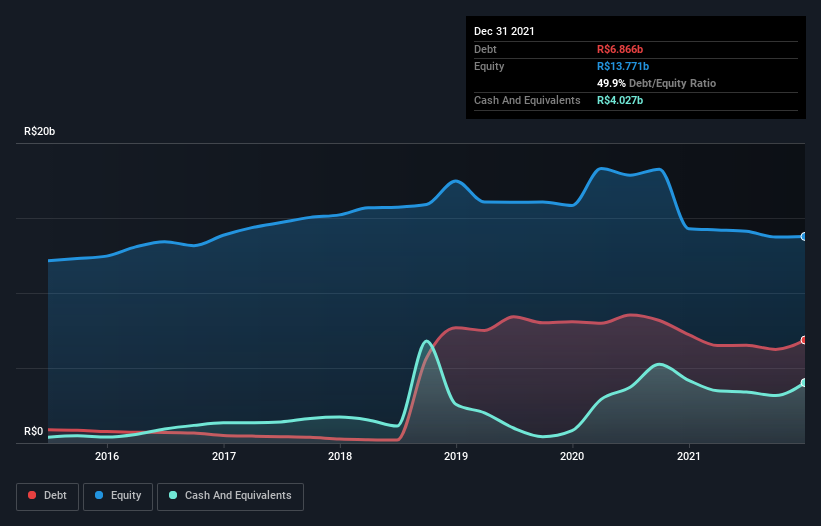- Brazil
- /
- Consumer Services
- /
- BOVESPA:COGN3
Cogna Educação (BVMF:COGN3) Takes On Some Risk With Its Use Of Debt
Legendary fund manager Li Lu (who Charlie Munger backed) once said, 'The biggest investment risk is not the volatility of prices, but whether you will suffer a permanent loss of capital.' It's only natural to consider a company's balance sheet when you examine how risky it is, since debt is often involved when a business collapses. Importantly, Cogna Educação S.A. (BVMF:COGN3) does carry debt. But the more important question is: how much risk is that debt creating?
When Is Debt A Problem?
Generally speaking, debt only becomes a real problem when a company can't easily pay it off, either by raising capital or with its own cash flow. In the worst case scenario, a company can go bankrupt if it cannot pay its creditors. However, a more frequent (but still costly) occurrence is where a company must issue shares at bargain-basement prices, permanently diluting shareholders, just to shore up its balance sheet. Of course, plenty of companies use debt to fund growth, without any negative consequences. The first step when considering a company's debt levels is to consider its cash and debt together.
See our latest analysis for Cogna Educação
How Much Debt Does Cogna Educação Carry?
As you can see below, Cogna Educação had R$6.87b of debt at December 2021, down from R$7.22b a year prior. However, it does have R$4.03b in cash offsetting this, leading to net debt of about R$2.84b.

How Strong Is Cogna Educação's Balance Sheet?
Zooming in on the latest balance sheet data, we can see that Cogna Educação had liabilities of R$4.09b due within 12 months and liabilities of R$10.7b due beyond that. On the other hand, it had cash of R$4.03b and R$2.45b worth of receivables due within a year. So its liabilities total R$8.26b more than the combination of its cash and short-term receivables.
This deficit casts a shadow over the R$4.67b company, like a colossus towering over mere mortals. So we definitely think shareholders need to watch this one closely. At the end of the day, Cogna Educação would probably need a major re-capitalization if its creditors were to demand repayment.
We measure a company's debt load relative to its earnings power by looking at its net debt divided by its earnings before interest, tax, depreciation, and amortization (EBITDA) and by calculating how easily its earnings before interest and tax (EBIT) cover its interest expense (interest cover). This way, we consider both the absolute quantum of the debt, as well as the interest rates paid on it.
Weak interest cover of 0.18 times and a disturbingly high net debt to EBITDA ratio of 10.3 hit our confidence in Cogna Educação like a one-two punch to the gut. This means we'd consider it to have a heavy debt load. One redeeming factor for Cogna Educação is that it turned last year's EBIT loss into a gain of R$77m, over the last twelve months. The balance sheet is clearly the area to focus on when you are analysing debt. But it is future earnings, more than anything, that will determine Cogna Educação's ability to maintain a healthy balance sheet going forward. So if you want to see what the professionals think, you might find this free report on analyst profit forecasts to be interesting.
Finally, a company can only pay off debt with cold hard cash, not accounting profits. So it is important to check how much of its earnings before interest and tax (EBIT) converts to actual free cash flow. Happily for any shareholders, Cogna Educação actually produced more free cash flow than EBIT over the last year. That sort of strong cash generation warms our hearts like a puppy in a bumblebee suit.
Our View
On the face of it, Cogna Educação's interest cover left us tentative about the stock, and its level of total liabilities was no more enticing than the one empty restaurant on the busiest night of the year. But at least it's pretty decent at converting EBIT to free cash flow; that's encouraging. We're quite clear that we consider Cogna Educação to be really rather risky, as a result of its balance sheet health. So we're almost as wary of this stock as a hungry kitten is about falling into its owner's fish pond: once bitten, twice shy, as they say. While Cogna Educação didn't make a statutory profit in the last year, its positive EBIT suggests that profitability might not be far away. Click here to see if its earnings are heading in the right direction, over the medium term.
Of course, if you're the type of investor who prefers buying stocks without the burden of debt, then don't hesitate to discover our exclusive list of net cash growth stocks, today.
New: AI Stock Screener & Alerts
Our new AI Stock Screener scans the market every day to uncover opportunities.
• Dividend Powerhouses (3%+ Yield)
• Undervalued Small Caps with Insider Buying
• High growth Tech and AI Companies
Or build your own from over 50 metrics.
Have feedback on this article? Concerned about the content? Get in touch with us directly. Alternatively, email editorial-team (at) simplywallst.com.
This article by Simply Wall St is general in nature. We provide commentary based on historical data and analyst forecasts only using an unbiased methodology and our articles are not intended to be financial advice. It does not constitute a recommendation to buy or sell any stock, and does not take account of your objectives, or your financial situation. We aim to bring you long-term focused analysis driven by fundamental data. Note that our analysis may not factor in the latest price-sensitive company announcements or qualitative material. Simply Wall St has no position in any stocks mentioned.
About BOVESPA:COGN3
Cogna Educação
Operates as an educational organization in Brazil and internationally.
Undervalued with adequate balance sheet.
Similar Companies
Market Insights
Community Narratives



